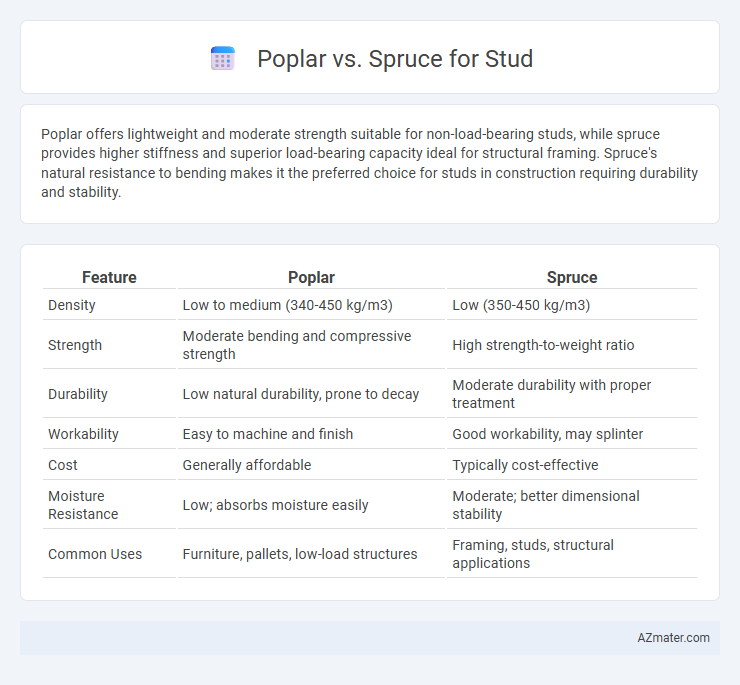Poplar offers lightweight and moderate strength suitable for non-load-bearing studs, while spruce provides higher stiffness and superior load-bearing capacity ideal for structural framing. Spruce's natural resistance to bending makes it the preferred choice for studs in construction requiring durability and stability.
Table of Comparison
| Feature | Poplar | Spruce |
|---|---|---|
| Density | Low to medium (340-450 kg/m3) | Low (350-450 kg/m3) |
| Strength | Moderate bending and compressive strength | High strength-to-weight ratio |
| Durability | Low natural durability, prone to decay | Moderate durability with proper treatment |
| Workability | Easy to machine and finish | Good workability, may splinter |
| Cost | Generally affordable | Typically cost-effective |
| Moisture Resistance | Low; absorbs moisture easily | Moderate; better dimensional stability |
| Common Uses | Furniture, pallets, low-load structures | Framing, studs, structural applications |
Introduction: Poplar vs. Spruce for Studs
Poplar and spruce are common wood choices for studs in construction, each offering distinct structural properties. Poplar is valued for its lightweight nature and smooth texture, making it easy to work with, but it generally has lower strength and durability compared to spruce. Spruce provides superior load-bearing capacity and rigidity, often preferred in framing due to its higher strength-to-weight ratio and resistance to warping.
Overview of Poplar and Spruce Woods
Poplar wood is lightweight, moderately soft, and easy to work with, making it suitable for interior framing and non-load-bearing studs, while spruce stands out for its higher strength-to-weight ratio, stiffness, and consistent grain, ideal for structural studs in construction. Spruce offers greater dimensional stability and resistance to warping, making it a preferred choice for load-bearing applications where durability and strength are critical. Both woods are readily available and cost-effective, but spruce's superior mechanical properties align better with building codes for structural framing.
Physical Properties Comparison
Poplar offers a lighter density of approximately 400 kg/m3 compared to spruce's 450 kg/m3, providing easier handling and reduced wall load in stud applications. Spruce exhibits higher compressive strength, typically around 38 MPa, surpassing poplar's 30 MPa, making it more suitable for structural stability in load-bearing walls. Poplar's moderate hardness and better dimensional stability reduce warping risks, whereas spruce's higher stiffness contributes to greater rigidity in framing.
Strength and Durability
Poplar offers moderate strength and is lightweight, making it easier to work with for framing studs but less durable under heavy loads compared to spruce. Spruce, characterized by higher density and greater load-bearing capacity, provides superior strength and durability for structural applications such as studs. Builders often prefer spruce for stud framing due to its combination of strength, stiffness, and resistance to wear and deformation.
Workability and Ease of Use
Poplar offers superior workability compared to spruce due to its softer texture and consistent grain, making it easier to cut, shape, and nail without splitting. Spruce, while lightweight and strong, tends to have a more irregular grain pattern that can cause challenges in machining and woodworking precision. For stud applications, poplar's ease of use accelerates construction processes and reduces tool wear, making it a preferred choice in detailed or custom framing projects.
Cost and Availability
Poplar studs are generally more affordable and widely available in North American markets due to their rapid growth and abundance, making them a cost-effective choice for construction projects requiring multiple studs. Spruce studs, often sourced from boreal forests, tend to be slightly more expensive but offer stronger structural integrity and are commonly found in regions with established coniferous lumber industries. Builders prioritize poplar for budget-sensitive framing jobs where ease of handling and availability are critical, while spruce is chosen for projects demanding higher load-bearing capabilities despite a higher material cost.
Common Applications in Construction
Poplar is commonly used for interior construction projects such as framing, woodworking, and furniture due to its lightweight and moderate strength properties. Spruce is favored in structural applications like wall studs, roof trusses, and flooring because of its higher stiffness, strength, and durability. Both woods are popular choices for stud framing, but spruce's superior load-bearing capabilities make it more suitable for heavy-duty construction needs.
Environmental Impact and Sustainability
Poplar and spruce differ significantly in environmental impact and sustainability when used as stud materials. Poplar grows faster and requires less intensive forestry practices, making it a more renewable resource with a lower carbon footprint. Spruce, while strong and widely used, often comes from slower-growing conifers, leading to slower forest regeneration and potentially higher environmental costs.
Pros and Cons of Using Poplar for Studs
Poplar offers lightweight and affordable characteristics, making it easy to handle and cost-effective for stud framing, but it lacks the strength and durability compared to spruce, which has higher load-bearing capacity and resistance to deformation. The softness of poplar can lead to dents and damage during installation, reducing long-term structural integrity. Spruce's superior stiffness and moisture resistance make it more reliable for supporting heavy loads and maintaining stability in framing applications.
Pros and Cons of Using Spruce for Studs
Spruce is favored for studs due to its high strength-to-weight ratio and excellent dimensional stability, making it ideal for framing and load-bearing applications. It offers good resistance to shrinking and warping but is more susceptible to denting and damage compared to denser hardwoods like poplar. Spruce's cost-effectiveness and wide availability enhance its appeal, yet its relatively low resistance to moisture and decay requires proper treatment or indoor use to ensure durability.

Infographic: Poplar vs Spruce for Stud
 azmater.com
azmater.com